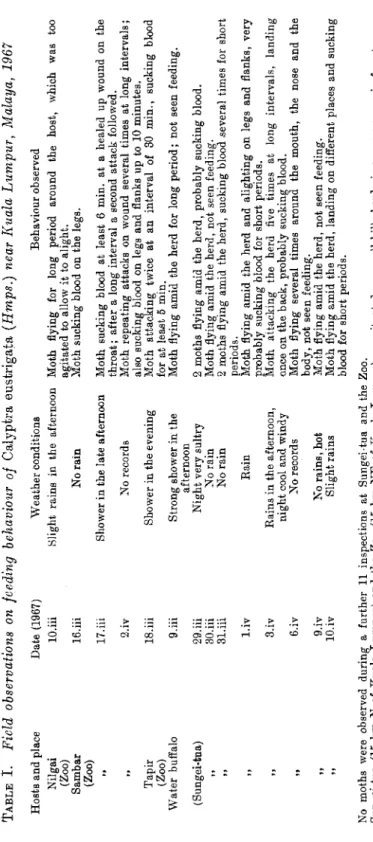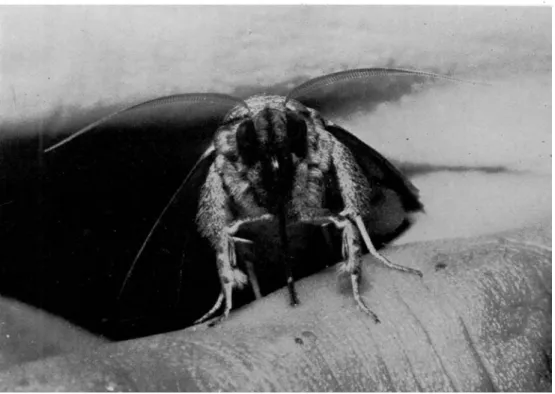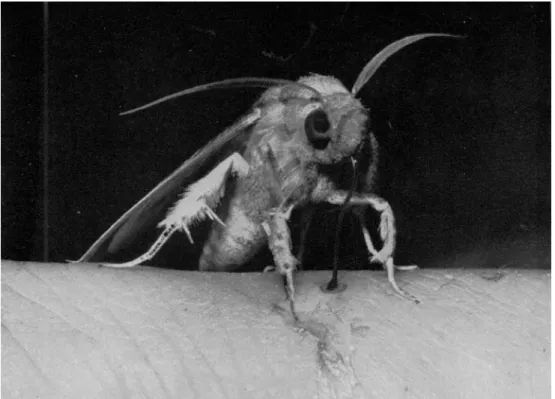Research Collection
Journal Article
Preliminary observations on a skin-piercing blood-sucking moth (Calyptra eustrigata (Hmps.) (Lep., Noctuidae)) in Malaya
Author(s):
Bänziger, H.
Publication Date:
1968
Permanent Link:
https://doi.org/10.3929/ethz-b-000422573
Originally published in:
Bulletin of Entomological Research 58(1), http://doi.org/10.1017/S0007485300055942
Rights / License:
In Copyright - Non-Commercial Use Permitted
This page was generated automatically upon download from the ETH Zurich Research Collection. For more
information please consult the Terms of use.
159
PEELIMINAEY OBSERVATIONS ON A SKIN-PIERCING BLOOD-SUCKING MOTH (CALYPTRA EUSTRIGATA (HMPS.) (LEP., NOCTUIDAE))
IN MALAYA
By H. BANZIGER
(Plates IX & X)
c/o Department of Entomology, Federal Institute of Technology, Zurich, Switzerland
(Received 2nd February 1968)
By examining the stomach contents of the eye-frequenting Noctuid moths Lobocraspis griseifusa Hmps. and Arcyophora sylvatica Biittiker, Buttiker (1959a, b, and unpublished records) showed that these species occasionally ingest blood.
However, the details of this peculiar feeding habit of eye-frequenting Lepidoptera have so far remained unknown and no information on the mode of uptake has been published.
The first direct observations on blood-sucking moths were made in the course of entomological work in the field * in Thailand and Malaya between 1965 and 1967, when it was established that there are two groups of these moths: those which pierce the skin and suck blood and those which " lick " the skin and suck blood.
This paper is concerned with the behaviour of Calyptra eustrigata (Hmps.), a Noctuid which is a member of the first group, and which has a strong proboscis that enables it to pierce the skin of a number of mammalian hosts.
The moths of the second group, upon which it is intended to report elsewhere at a later date, are unable to pierce the skin, apparently because the proboscis is too weak. They either suck blood from open wounds, or imbibe the tiny droplets of blood that are sometimes present in large numbers on the body of bovines.
These droplets are shed by mosquitos which excrete part of the blood that they themselves have ingested. Some of these skin-licking blood-imbibing Lepidoptera are also eye-frequenting, that is, members of a group of moths which take up lachrymal secretions from Ungulata and elephants (Buttiker, 1962b, 1964, 1967) and occasionally from human beings (Banziger, 1966).
Related species of the genus Calyptra, including 0. emarginata (F.), G.
provocans (Wlk.), and C. minuticomis (Gn.) (Kalshoven, 1951; Neubecker, 1960), are well-known in Africa and South Asia as fruit-piercing moths. Moreover, in Cambodia the last species has once been captured from the eye of a water buffalo (Buttiker, 19626) and would therefore appear to be an occasional eye-frequenter as well.
Observations in the field
Records of the behaviour of Calyptra eustrigata were made in March and April 1967 in the course of nocturnal observations made while investigating eye-frequent- ing moths in Malaya. The observation sites, which were on a number of farms at Sungei-tua (approximately 15 km. north of Kuala Lumpur) and also in the
i Investigations sponsored by the Swiss Federal Institute of Technology, Ziirich and the Royal Thai Government as part of a UNESCO programme.
O5 o Hosts and place Nilgai (Zoo) Sambar
Date (1967) lO.iii 16.iii
Weather conditions Slight rains in the afternoon No rain Tapir (Zoo) Water buffalo (Sungei-tua)
2.iv
TABLE
I . Field observations on feeding behaviour of Calyptr a eustrigat a (Hmps.) near Kuala Lumpur, Malaya, 1967
Behaviour observed Moth flying for long period around the host, which was too agitated to allow it to alight. Moth sucking blood on the legs. Moth sucking blood at least 6 min. at a healed up wound on the throat; after a long interval a second attack followed. Moth repeating attacks on wound several times at long intervals; also sucking blood on legs and flankB up to 10 minutes. Moth attacking twice at an interval of SO min., sucking blood for at least 5 min. Moth flying amid the herd for long period; not seen feeding. 2 moths flying amid the herd, probably sucking blood. Moth flying amid the herd, not seen feeding. 2 moths flying amid the herd, sucking blood several times for short periods. Moth flying amid the herd and alighting on legs and flanks, very probably sucking blood for short periods. Moth attacking the herd five times at long intervals, landing once on the back, probably sucking blood. Moth flying several times around the mouth, the nose and the body, not seen feeding. Moth flying amid the herd, not seen feeding. Moth flying amid the herd, landing on different places and sucking blood for short periods. No moths were observed during a further 11 inspections at Sungei-tua and the Zoo. Sungei-tua (15 km N of Kuala Lumpur) and the Zoo (15 km NE of Kuala Lumpur) are situated on small hills bordering evergreen rain-forests.l.iv 3.iv 6.iv 9.iv lO.iv
Shower in the late afternoon No records Shower in the evening Strong shower in the afternoon Night very sultry No rain No rain Rain Eains in the afternoon, night cool and windy No records No rains, hot Slight rains
W
OBSERVATIONS ON CALYPTRA EVSTRIOATA (HMPS.) IN MALAYA 1 6 1
Zoological Gardens of Kuala Lumpur, were in a region of undulating hills covered with primary and secondary rain-forest and rubber plantations.
Adults of C. eustrigata were seen on 14 occasions on hosts that included the following: water buffalo (Bubalus bubalis), sambar deer (Cervus unicolor), Malayan tapir (Tapirus indicus) and nilgai antelope (Boselaphus tragocamelus), and details of the observations are presented in Table I. The moths rapidly approached the animals at a height of six metres or more above ground, a flight path relatively high in comparison with those of other blood-sucking moths. When near their hosts they dived and circled around them in a faltering flight, apparently locating an attractive spot. On the whole, all parts of the body were visited equally often.
On two nights a healed wound on a sambar deer was attacked by a moth repeatedly, and notwithstanding the fact that the moth was dislodged several times by the host, it invariably returned to the same place. One specimen was observed imbibing blood on the flank of a sleeping tapir for fully five minutes, after which the host became aware of our presence and ran away.
Observations on caged moths
The observations made in the field led to experiments on a human subject using caged adults of C. eustrigata in order to obtain more detailed information on their feeding behaviour. By breathing upon the moths, their attention was drawn to moistened fingers held inside the cages. As soon as a moth encountered the fingers, it settled on one of them and began to palpate the skin with its proboscis, and shortly thereafter thrust the proboscis vertically against the skin and tried to pierce it. The spots most commonly pierced appeared to be the pores of the hairs. The dagger-shaped sclerotised tip of the proboscis was pressed against the skin so that the whole proboscis became curved. At the same time, the moth's head began to oscillate rather like the balance wheel of a watch. This movement induced the middle part of the proboscis to vibrate so rapidly that the whole resembled a spindle. Whenever the skin proved impenetrable, the moth tried again at another point near by. As soon as the proboscis successfully perforated the skin, the subject felt strong burning pains which were described as being like those caused by a hot needle. Thereafter the rate of penetration was more rapid, probably because the tissue encountered was softer and the sawing mechanism worked more efficiently as the barbs of the proboscis gripped the tissues. Once inserted, the proboscis remained straight whilst the oscillating movements of the head continued. It was possible to study the working of the mouth parts with a magnifying glass. When they were in operation, the two halves of the proboscis moved rapidly along their longer axis in opposite directions. This mechanism was effective, provided that at the outset sufficient force could be brought to bear to thrust the proboscis into the tissues, because one half of the proboscis could then anchor itself within the tissues, whilst the other penetrated more deeply.
The oscillating motion of the head seemed to assist this movement. In addition to its boring action, the whole proboscis was moved up and down at irregular intervals within the hole in the skin. This upward and downward movement was made with so little difficulty as to suggest that a wide shaft had been rasped out.
Quite often droplets of saliva, originating below the palps, were seen to run down the outer side of the proboscis; sometimes saliva appeared at the base of the proboscis even before the skin had been pierced. Frequently, some of the ingested blood was regurgitated, and a drop would appear at the aperture of the shaft, but as a rule it was quickly re-ingested. In the meanwhile, the sawing motion of the proboscis continued. After a while, a whitish swelling appeared on the skin around the point of entry of the proboscis. The greatest depth of penetration was about six millimetres. After 10 to 30 minutes had elapsed, dark-red drops of blood were excreted by the moth but the sawing motion
(L 3521)
L162 H. BANZIGER
continued. Blood-sucking occupied from 10 to 60 minutes and blood continued to flow out of the wound for a few minutes after its cessation. Hours and sometimes even days later, the wound was still itching. The skin around the site of the puncture became hardened and this could be felt for at least five weeks.
The wound itself, however, remained painful for only a short time.
The experiments were repeated 26 times. In 16 instances the moths pierced the skin and sucked blood; in four they sucked blood from open and superficial wounds on a finger that had been made by means of a knife, and in six they were not able to pierce the skin or made no attempt to do so.
On several occasions, peaches, grapes, oranges and plums were offered to individual adults of G. eustrigata, but only peaches were attacked, and it was only some of the moths that attacked these.
Discussion
The foregoing observations made of the skin-piercing and blood-sucking habit of Calyptra eustrigata in Malaya are the first to be recorded. In Thailand, we were unable to obtain any evidence of the occurrence of this moth although for 20 months we there investigated eye-frequenting moths that live under similar biological circumstances as C. eustrigata. From our own experience and from references in literature it would seem that this species occurs mainly in Malaya, India and Ceylon. This Noctuid was not common at the time of our visit as we found only 25 specimens in the course of four weeks' field work.
According to the preliminary observations made in the neighbourhood of Kuala Lumpur, the usual hosts of the moth were members of the families Bovidae and Cervidae. In one instance even a tapir was attacked. The preferred hosts of the eye-frequenting moths also belong to the Bovidae and Cervidae.
This feeding habit of C. eustrigata suggests the possibility that the moth may play a role as a vector of diseases of man and animals. The ability to pierce the skin may open a way for pathogens, as the bore of the feeding track is com- paratively large, as is shown by the sustained flow of blood after the proboscis has been withdrawn. The secretion of saliva during sucking may also be important, since vectors of disease, such as mosquitos, can transmit pathogens with their saliva. The strong itching suggests that extraneous fluid, such as saliva, enters the wound and gives rise to local inflammation. The subsequent hardening of the skin may be the result of haemorrhage in the damaged tissues accompanied by slight infection or else may be a reaction of the tissue to wounding. However, notwithstanding the observations made under experimental conditions, we have not so far seen any attempt by C. eustrigata to attack man in the field.
Some laboratory experiments have shown that C. eustrigata pierces fruit. The fruit-piercing behaviour is well-known in other species of the genus and has been reported from many countries. Possibly C. eustrigata was formerly a typical fruit-piercing moth; but it would now seem to be evolving into a blood-sucker.
Such a change would render it largely independent of the presence of ripe fruit, as blood-feeding is possible throughout the year. The evolutionary path that this behaviour seems to foreshadow parallels that which has already been taken in mosquitos.
Further investigations are being carried out on the economic status, biology and distribution of this Noctuid.
Summary
In the course of entomological investigations in Malaya between 1965 and
1967, it was found that Calyptra eustrigata (Hmps.) (Noctuidae) frequently pierces
the skin of mammals to feed on blood, and in this respect differs from those
OBSERVATIONS ON CALYPTRA EUSTRIGATA (HMPS.) IN MALAYA 1 6 3
Noctuids that merely imbibe blood from an open wound. Other species of Galyptra are known as fruit-piercing moths, and C. minuticornis (Gn.) which was taken in Cambodia on one occasion at the eye of a buffalo, is also one of the eye-frequenting moths, which imbibe lachrymal secretions of Ungulata, Proboseidea and occasionally of man. C. eustrigata has been observed imbibing blood after piercing the skin of buffalo, Sambar deer, Malayan tapir and nilgai antelope. Caged adults in the laboratory were observed piercing the skin of human fingers offered to them; and imbibition of blood continued for up to an hour.
The proboscis, which ends in a sclerotised and strongly barbed point, can penetrate about six millimetres below the surface. The two halves of the proboscis work like two paralled saws moving alternately. While feeding is in progress, droplets of saliva exude at the base of the proboscis and run down the outside.
Often some blood is regurgitated, then reabsorbed. The puncture causes itching, which can last for up to an hour, and local hardening of the tissue, which can persist for five weeks. By reason of its mode of feeding, C. eustrigata would appear to be a potential vector of disease, as the saliva and regurgitated fluids might transmit pathogenic agents.
Acknowledgements
The author takes great pleasure in extending his sincerest thanks to Dr. W.
Buttiker, c/o CIBA Ltd., Basle, for guidance and continuous support; to Prof.
Dr. P. Bovey, Federal Institute of Technology, Zurich, for providing a special research grant; to Dr. K. Ehode, University of Malaya, Kuala Lumpur, for the many facilities and advice given; and to the Director of the National Zoological Gardens, Kuala Lumpur, for permission to carry out investigations at night. He is also very grateful to the Governments of Malaya and Thailand for their help during his stay in these countries.
References
BANZIGER,
H. (1966). First records of eye-frequenting Lepidoptera from man (preliminary communication).—WHO/EBL 66.81, 13 pp., multigraph.
BUTTIKER,
W. (1959a). Observations on feeding habits of adult Westermanniinae (Lepid., Noctuidae) in Cambodia.—Ada trop. 16 pp. 356-361.
BUTTIKER,
W. (19596). Blood-feeding habits of adult Noctuidae (Lepidoptera) in Cambodia.—Nature, Lond. 184 no. 4693 (suppl. 15) p. 1167.
BUTTIKER,
W. (1962a). Notes on two species of Westermanniinae (Lepidoptera:
Noetuidae) from Cambodia.—Proc. B. ent. Soc. Lond. (B) 31 pp. 73-76.
BUTTIKER,
W. (1962b). Biological and morphological notes on the fruit-piercing and eye-frequenting moths.—Verh. XI. int. Kongr. Ent. 1960, 2 pp.
10-15.
BUTTIKER,
W. (1964). New observations on the eye-frequenting Lepidoptera from S.E. Asia.—Verh. naturf. Ges. Basel 75 pp. 231-236, 6 pis. (1 col.).
BUTTIKER,
W. (1967). Biological notes on eye-frequenting moths from N.
Thailand.— Mitt. Schweiz. Ent. Ges., 39 (3-4), 151-179.
KALSHOVEN,
L. G. E. (1951). De plagen van de cultuurgewassen in Indonesie.
Deel II.—pp. 513-1065. 's-Gravenhage, W. van Hoeve.
NEUBECKER,
F. (1966). Noctuiden Imagines als Schadlinge in den Tropen und Subtropen. Zeitschrift f. angew. Entomologie, 58 pp. 82-88.
© Commonwealth Agricultural Bureaux, 1968
BULL. ENT RES. VOL. 58 PLATE IX
FIG. 1. C. eustrigata attempting to pierce the skin of the author's finger. The point of the proboscis is being pressed against the skin, as is indicated by the stretched position of the
protarsi. About 3 5 x n a t . size. (Photo Banziger.)
3 -*
FIG. 2. C. eustrigata piercing the skin. Part of the saw-tooth armature of the proboscis still visible. (Photo Banziger.)
BULL. ENT. RES. VOL. 58 PLATE X
FIG. 1. C. eustrigata re-ingesting blood that has been regurgitated a few seconds earlier.
proboscis still remains in the wound. (Photo Banziger.) The
FIG. 2. C. eustrigata, with abdomen distended, about to finish sucking, as indicated by


